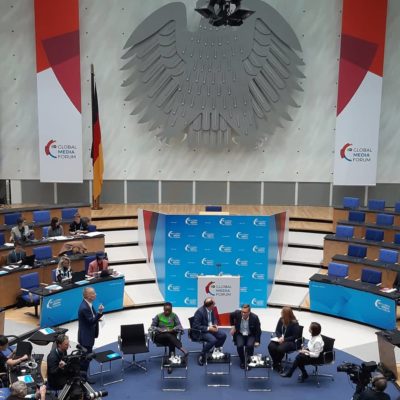Photo: Deutsche Welle
by Dobriyana Tropankeva
During the Deutsche Welle Global Media Forum 2019 and shortly after the European Parliament elections, Isabelle Sonnenfeld, from the Google News Initiative, hosted a workshop on the timely topic of “Covering elections: From research to fact checking to securing your accounts”.
In her talk, she highlighted that it is important to first understand the difference between misinformation and disinformation and shared the following definitions:
“Misinformation is information that is false but the person, who is disseminating it, believes that it is true.”
“Disinformation is information that is false and the person, who is disseminating it, knows that it is false.”
The second one is deliberate intentional lie. There is a different reasoning between the two and that is why it is important to label them accordingly.
The next important step is to know the motivation for creating the content. Sonnenfeld listed eight reasons why mis- and dis-information is created and shared.
They included:
- Poor journalism
- To parody
- To provoke or ‘punk’
- Passion
- Partisanship
- Profit
- Political Influence
- Propaganda
So finding out the reasons for posting is equally important to determine the type of content.
Another key factor is the source, for example, knowing whether the information is coming from an eyewitness, activist or journalist. Sonnenfeld outlined source verification process as follows: review social history, make contact with the source, ask questions and secure permission to use and, finally, to ensure source and content are consistent.
When asked about how to combat the rise of deepfakes, which are falsified videos created with AI-based technology, Sonnenfeld said:
“The biggest challenge is that we now have to understand the impact that deepfakes can have. It is partly a question of technology or finding a solution to that. But also it is important to provide media literacy on that topic, not just to journalists, but also to all media users and readers, who need to understand the impact of deepfakes.”
During her workshop in a room packed with journalists from all over the world, Sonnenfeld presented a selection of practical media fact-checking and verifications tools that can be found online.
- Reverse image search
Images and videos can be checked with reversed image search. A great starting point is to fact check images, video thumbnails or screenshots via Google search. Another option is to use Tin Eye that gives you access to other search engines in addition to the Google search engine. For videos, a useful tool is the InVID Project. First Draft has also published a checklist for visual identification guide that you can find on their website.
- Find out what’s trending
Google trends can be a useful tool to show, if and when a topic was searched at specific time, keywords and trends.
- Check the location
Geotagging and metadata of images are a good starting point but they need to be considered with caution and further verified, as they can be easily faked or in the case of metadata – deleted. Google Earth and Google Maps offer a great access and features in order to fact check locations. For example in a street view mode on Google Maps, you can see store signs, street layouts, statues, monuments, car license plates, architectural and natural landmarks, that will give you clues of where a photo or video was taken. In Google Street View and Google Earth timeline, there is an option to go back in time and see how location changed over time.
- Find out when
YouTube DataViewer is a tool built by Amnesty International. It is a really useful tool that shows when a video was uploaded, including date and local time.
- Use website archives
Session Buddy helps to save open tabs in a browser for later use. Another handy tool is the Wayback Machine, which can help you find archived and previous version of web pages.




